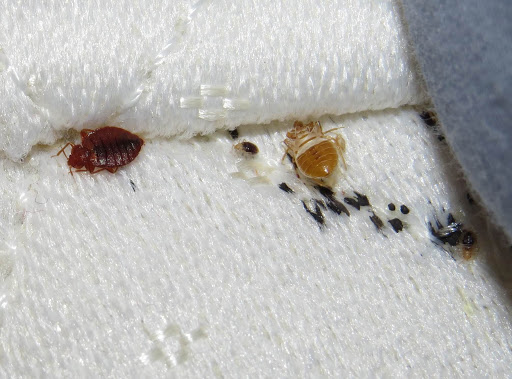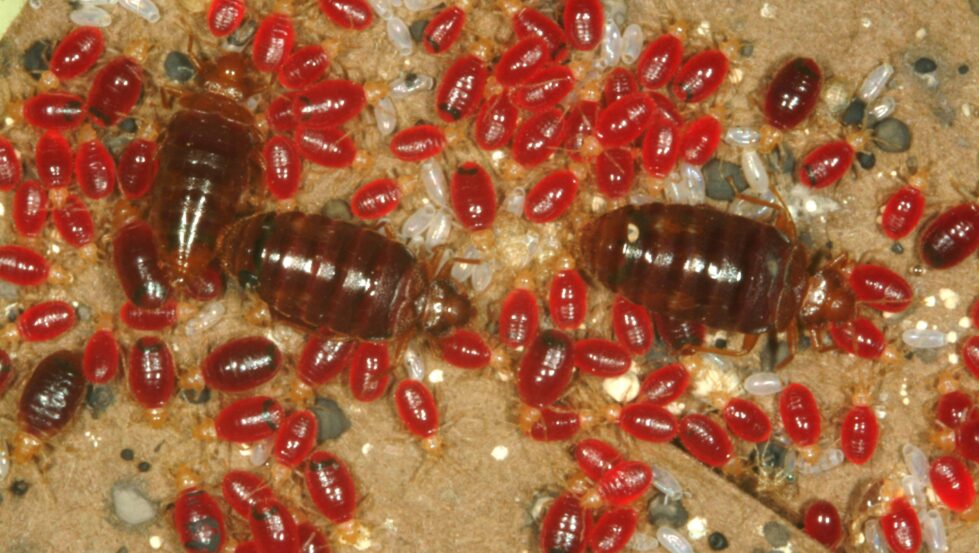Bed bugs are the most common pests to invade your home. There are many ways you can spot these pesky critters and keep them out of your bed, clothes, and furniture. Keep reading for tips from our pest control professionals on how to identify signs of bed bugs in your home.
What are bed bugs?

Bed bugs are small, oval-shaped insects that feed on the blood of humans and other animals. They typically live in beds, but they can be found anywhere where there is a steady supply of food. The name “bed bugs” likely comes from their habit of taking refuge in beds and feeding on humans while they sleep.
These bloodsuckers feed only on human blood, meaning the pests need to have regular meals before they can survive or develop into adulthood. Humans are not bed bug’s only targets; these critters will attack many warm-blooded animals, including poultry and other birds.
“Sleep tight, don’t let the bed bugs bite!”
Before the mid-20th century, bed bugs were very common. According to a report by the UK Ministry of Health, in 1933, all the houses in many areas had some degree of bed bug infestation. The increase in bed bug populations in the early 20th century has been attributed to the advent of electric heating, which allowed bed bugs to thrive year-round instead of only in warm weather.
Bed bugs were first mentioned in Germany in the 11th century, in France in the 13th century, and in England in 1583, though they remained rare in England until 1670. Mattresses were often stuffed using straw, shredded corn husks, or down feathers. These materials attracted bed begs, hence, the old “don’t let the bed bugs bite!” phrase.
Signs of bed bug infestation
- You notice small blood spots on your sheets or mattress. Check the mattress for bed bugs by flipping it over and looking for small blood stains or black dots
- Your child’s bedding is infested with live or dead bed bugs.
- The bug bites you’re getting don’t seem to go away, and they itch like crazy!
- You may see the actual bed bugs. They are generally small, but adult bed bugs can be seen with the naked eye. Adult bed bugs are usually brown in color. When filled with blood, their color ranges from red to dark brown. They are oval in shape and about the size of a flattened apple seed.
How to get rid of bed bugs – pesticides or thermal heat treatment?
Pest control companies that specialize in Bed Bug removal and control use various treatments to eradicate bed bugs. In most cases, this is the only true way to completely get rid of bed bugs.
The number one way to get rid of bed bugs is with thermal heating treatment. This thermal heat treatment will heat up an entire room or house to 140 degrees, which kills the adult bed bugs and eggs.
Thermal treatments are properly complemented and coupled with the appropriate use of control chemistries in harborage areas and the use of IGRs (insect growth regulators/reproductive regulation) to control the reproduction of any surviving bugs.
Some pest control companies still use pesticides for bed bug treatment, however, many homeowners are wary of pesticides, especially if they have children or pets. The use of thermal heat treatment for bed bug eradication is safe and effective.
Tips for preventing bedbug infestation in your home
1. Be sure that your home is clean
2. Invest in bed bug-proof mattress and box spring encasements, which are designed to keep bugs away from the bed
3. Vacuum your room regularly and be sure not to leave any crumbs or food out on the counter
4. Use a steamer to kill bugs that may have made their way into your clothing
6. Be aware of where you’re traveling – some hotels can have bedbugs too! Clean all clothing immediately when returning home and consider spraying all luggage with bedbug insect spray before bringing it into the home.
5. If you’re still having problems with bed bugs, call a bed bug pest control company for help killing these pests for good!
Important Bed Bug FAQs
Q: How can bed bugs get into my home?
A: They can come from other infested areas or from used furniture. They can hitch a ride in luggage, purses, backpacks, or other items placed on soft or upholstered surfaces. They can travel between rooms in multi-unit buildings, such as apartment complexes and hotels.
Q: Should I throw out my mattress if I have bed bugs?
A: No, you do not need to throw out your mattress after a bed bug infestation. In fact, this is discouraged. Disposing bed bug infested items can be seem reckless, as it could contribute to the infestation spreading. Disposing of a mattress which has been professionally treated is your best option if you simply do not want to keep it after having bed bugs.
Q: Does washing clothes kill bed bugs?
A: Washing clothes at very hot temperatures will kill bed bugs without the need for a hot heat dry cycle—although adding a drying cycle will help insure bed bugs are killed. Research has found one hundred percent of bed bugs were killed when wash water was at 140 degrees F.
Q: What do bed bug bites look and feel like?
A: Almost all bed bug bites will produce some degree of discomfort, typically itchiness and inflammation. Other signs and symptoms of bed bug bites include a burning painful sensation, a raised itchy bump with a clear center, a red itchy bump with a dark center and lighter swollen surrounding area, small red bumps or welts in a zigzag pattern or a line, small red bumps surrounded by blisters or hives, papular eruptions or areas of skin with raised or flat patches that may be inflamed. People who are highly allergic to bug bites need to pay extra caution.
Bed Bug Treatment in Virginia
Call us for any bed bug or other pest infestations you have! Our staff consists of some of the highest educated and experienced biologists in the industry, bringing 50+ years of combined experience in wildlife management and pest control.
We utilize cutting-edge technology and a scientific approach to find an “Complete Effective” solution for every situation. Our mission is to effectively handle wildlife and pest problems in the most humane, professional, and environmentally friendly way possible.

